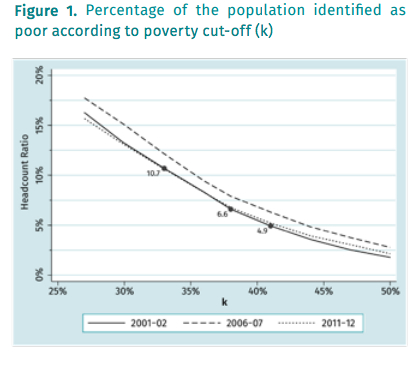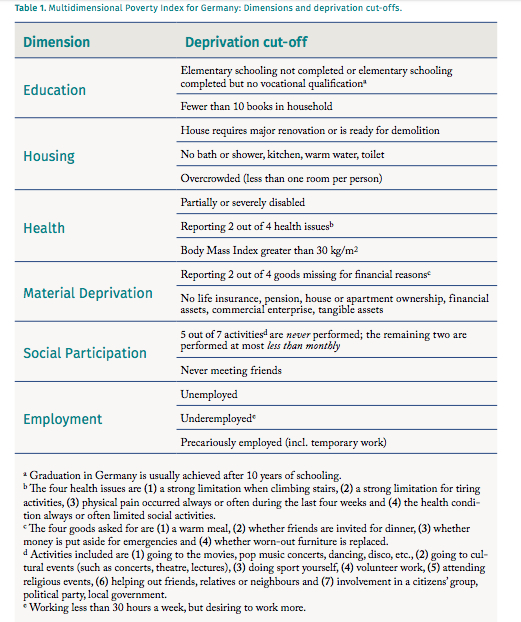
Search
Is There Poverty in Germany?

Can we talk meaningfully about poverty in an advanced economy like Germany? And if so, what does poverty look like? Or is poverty really something that societies leave behind once they are ‘developed’? Critics argue that the official German poverty measure, which follows a relative income approach, does not reflect real poverty.
Poverty is said to have many faces – a reality that becomes especially obvious when it is understood as consisting of multiple deprivations. One person may suffer from malnutrition, be unable to read and live in a subtropical rural area that lacks access to safe water. Another person, despite not being malnourished, might still have bad health and live a socially isolated existence in an urban area with insufficient shelter against cold and rain. Measures of multidimensional poverty that can detect multiple deprivations help to uncover, understand and ultimately fight some of the many manifestations of poverty.
In a paper published in Empirica, I propose a multidimensional poverty measure for an advanced economy like Germany. I pay special attention to both the conceptual integration into the capability approach and the German context. The proposed measure is based on the Alkire-Foster method and is calculated using the German Socio-Economic Panel data set (SOEP) for three points in time between 2001 and 2012.
To reveal my findings straightaway: there is multidimensional poverty in Germany. Figure 1 shows the number of people living in poverty (headcount ratio) for different poverty cut-offs, which are expressed as the percentage of deprivations a person needs to be deprived in to be identified as multidimensionally poor (in this case, the indicators are described in Table 1). In 2001/02, for instance, if we consider being deprived in at least one-third of all the indicators as our poverty cut-off (k=33% in Figure 1), 10.7% of the population would be identified as poor, whereas stricter poverty cutoffs of k=38% or k=41% still imply poverty rates of 6.6% and 5%, respectively.
The present article seeks to highlight specific aspects related to this proposal. Naturally, more details can be found in the paper itself.
The context is essential
Poverty measures cannot be compiled in vacuo. Quite the contrary, they always refer to a particular society at a given point of time, seeking to reflect the complex realities of poor people in that society while simultaneously respecting their values. Part of this context is that Germany is a rich country, having a more or less generous welfare state. Then again, it is not too difficult to observe people whose lives are ‘battered and diminished in all kinds ways’ (Amartya Sen).
The so-called reports on poverty and wealth represent another important element in that context. These reports have been published once a legislative period since the late 1990s and, among other things, monitor and analyse 17 core indicators of poverty. Drawing on these reports and related debates, the measure I propose comprises 15 indicators organised into six dimensions (education, health, housing, social participation, employment and material deprivation). Interestingly, the selected dimensions resemble what has also been chosen elsewhere in the world.
Data tends to be imperfect
The SOEP is a high-quality household panel-data set that has been successfully used for numerous research projects. However, these data, too, are still far from being perfect: many dimensions of human well-being are observed either incompletely, irregularly or not at all. An important implication is that resource information, i.e. information on means to achieve well-being rather than direct information about dimensions of well-being, has to be used as well. Therefore, a careful discussion of what indicators are ultimately meant to capture is also vital for this measurement exercise. For instance, it is important to include indicators for material and wealth deprivation, as these are related to otherwise ignored dimensions such as reasonable decision-making and economic security.
The public debate
The public debate plays a prominent role in the normative decisions needed for a fully-fledged poverty measure, including the selection of dimensions and indicators or the setting of poverty and deprivation thresholds. This is more than a formal requirement. In fact, the controversial, but rather inconclusive, debate on poverty in Germany largely revolves around finding the ‘correct’ poverty cut-off, while taking the relative income approach (and other parameters like equivalence scales) as given.
In contrast, the strategy to embed an Alkire-Foster-based poverty measure into the capability approach virtually invites, in fact, requires a public discussion about what actually constitutes poverty in the first place. While such a measure can frame the public discussion with a clear means-versus-ends distinction or offer candidate dimensions of human well-being, thus exposing the underlying normative decisions, it deliberately leaves these decisions open. It is up to a more reflexive and yet focussed public debate to address these questions and make a truly constructive contribution.
In fact, Spiegel-online, a major German news portal, published award-winning reportage asking precisely this question: What does it mean to be poor? The accompanying web resources allowed users to assess their own poverty status according to different poverty and deprivation measures.
The poverty cut-off
Besides indicator selection and the weighting scheme, the cross-dimensional poverty cut-off is another crucial parameter. Indeed, critics of poverty and deprivation measures for advanced economies often raise the concern that there will always be a bottom 10% in the population that has, say, relatively low education. This is, of course, true. Measures of multidimensional poverty, however, allow us to identify persons who are simultaneously deprived in multiple dimensions. If this is indeed our goal, then we are actually not worried about low education per se, but only to the extent that low education is coupled with, for instance, bad health, social isolation and unemployment. Only then is a person’s life evidently battered and diminished in numerous ways, which can be conceived as one manifestation of poverty. Therefore, requiring a person to be deprived in more than one indicator in order to be considered poor is vital for the present proposal and, moreover, allows us to go beyond a simple dashboard of indicators.
Mismatch with income poverty
An important finding of the study is the disagreement between income and multidimensional poverty measures about who is actually identified as poor. Given their respective parametric specifications (cut-offs, weights, etc.) each measure reports 10% to 13% of the German population to be poor. Although 23% are either MPI or income poor or both, only 5% of the population is both MPI and income poor. Robustness checks show that this small overlap not only emerges for one specific parameter set but is rather a finding robust to other relevant choices of the poverty cut-off. To put this result into perspective, one first has to recognise that Germany is an economy where many markets can be assumed to work, as market imperfections are often considered to account for such mismatches. More importantly, the multidimensional poverty measure already contains (i) material deprivation and wealth indicators as well as (ii) unemployment and precarious employment indicators. And yet, there is little agreement on who is poor.
Upon closer inspection, however, this result is quite intuitive, since income has been argued to be a bad proxy even for material well-being (e.g. due to consumption-smoothing and consumption streams from wealth). Subsequent evidence supports this hypothesis. For instance, of those who are income poor, but do not report any material deprivation, 46% report that they own their accommodation, 72% report that they have car, and 78% say they own wealth of 7,000 EUR or more. In fact, their median net wealth amounts to 66,000 EUR. While this analysis suggests that income poverty reports contain a substantial number of false positives (mistaken results), the results also indicate that a substantial share of the poor can only be identified using a true multidimensional measure that goes beyond material well-being.
Shortcomings
One major shortcoming of the present proposal is that some groups are currently ignored. While homeless people are not covered by the underlying survey, children are deliberately excluded because accurately capturing their well-being requires a distinct specification. A child’s well-being may deviate from an adult’s well-being, moreover, vary with developmental stages. Additionally, more complex dimensions of human well-being, like agency or self-respect, are currently still missing. Addressing these issues requires not only more methodological and substantive research, but also reinforced efforts in data collection.
A concluding remark
In sum, a multidimensional poverty measure for Germany certainly invites a fresh perspective on poverty in advanced economies that neither a single indicator nor a dashboard can provide. Moreover, the substantial disagreement about who is poor according to monetary and multidimensional poverty measures gives reason to expect quite disparate policy implications. Most importantly, only a well-designed measure, which reflects the realities of the lives people actually lead, can ultimately help to improve precisely these realities.
Comments are welcome at nsuppa@ced.uab.es
This article was published in Dimensions Magazine 6 (PDF).


















